Copper- and Iron-Based Nanoflowers in Cancer Theranostics
Abstract
1. Introduction
2. Synthesis Methods for Copper- and Iron-Based Nanoflowers
2.1. Co-Precipitation Method
2.2. Sol–Gel Method
2.3. Hydrothermal Method
2.4. Polyol Process
2.5. Microwave-Assisted Method
2.6. Sonochemical Method
2.7. Biomolecule Immobilization
2.8. One-Pot Biomineralization
2.9. Biological Method/Green Synthesis
3. Experimental Parameters’ Effect on Morphology of Nanoflowers
3.1. Effect of pH
3.2. Effect of Temperature
3.3. Effect of Incubation Time
4. Synthesis Methods and Applications of Flower-like Copper- and Iron-Based Nanostructures
4.1. Iron-Based NFs
4.2. Copper-Based NFs
4.3. Other Applications
5. Limitations and Future Perspectives
6. Conclusions
Author Contributions
Funding
Conflicts of Interest
References
- Siegel, R.L.; Miller, K.D.; Fuchs, H.E.; Jemal, A. Cancer Statistics, 2021. CA A Cancer J Clin. 2021, 71, 7–33. [Google Scholar] [CrossRef] [PubMed]
- Sri, S.; Chauhan, D.; Lakshmi, G.B.V.S.; Thakar, A.; Solanki, P.R. MoS2 Nanoflower Based Electrochemical Biosensor for TNF Alpha Detection in Cancer Patients. Electrochim. Acta 2022, 405, 139736. [Google Scholar] [CrossRef]
- Yarana, C.; St. Clair, D. Chemotherapy-Induced Tissue Injury: An Insight into the Role of Extracellular Vesicles-Mediated Oxidative Stress Responses. Antioxidants 2017, 6, 75. [Google Scholar] [CrossRef] [PubMed]
- Tsoupras, A.; Adamantidi, T.; Finos, M.A.; Philippopoulos, A.; Detopoulou, P.; Tsopoki, I.; Kynatidou, M.; Demopoulos, C.A. Re-Assessing the Role of Platelet Activating Factor and Its Inflammatory Signaling and Inhibitors in Cancer and Anti-Cancer Strategies. Front. Biosci. (Landmark Ed.) 2024, 29, 345. [Google Scholar] [CrossRef] [PubMed]
- Zhang, S.; Li, Q.; Yang, N.; Shi, Y.; Ge, W.; Wang, W.; Huang, W.; Song, X.; Dong, X. Phase-Change Materials Based Nanoparticles for Controlled Hypoxia Modulation and Enhanced Phototherapy. Adv. Funct. Mater. 2019, 29, 1906805. [Google Scholar] [CrossRef]
- Gkika, D.A.; Tolkou, A.K.; Evgenidou, E.; Bikiaris, D.N.; Lambropoulou, D.A.; Mitropoulos, A.C.; Kalavrouziotis, I.K.; Kyzas, G.Z. Fate and Removal of Microplastics from Industrial Wastewaters. Sustainability 2023, 15, 6969. [Google Scholar] [CrossRef]
- Freire, J.J.; Efthymiopoulos, P.; Ahmadi, A. Simulation Study of the G=4 PAMAM Dendrimer in Water at Different pH Conditions. Per. Politech. Chem. Eng. 2014, 58, 49. [Google Scholar] [CrossRef]
- Zhang, S.; Cao, C.; Lv, X.; Dai, H.; Zhong, Z.; Liang, C.; Wang, W.; Huang, W.; Song, X.; Dong, X. A H2O2 Self-Sufficient Nanoplatform with Domino Effects for Thermal-Responsive Enhanced Chemodynamic Therapy. Chem. Sci. 2020, 11, 1926–1934. [Google Scholar] [CrossRef]
- Chen, D.; Tang, Q.; Zou, J.; Yang, X.; Huang, W.; Zhang, Q.; Shao, J.; Dong, X. pH-Responsive PEG–Doxorubicin-Encapsulated Aza-BODIPY Nanotheranostic Agent for Imaging-Guided Synergistic Cancer Therapy. Adv. Healthc. Mater. 2018, 7, 1701272. [Google Scholar] [CrossRef]
- Sheikh Mohamed, M.; Veeranarayanan, S.; Maekawa, T.; Sakthi Kumar, D. External Stimulus Responsive Inorganic Nanomaterials for Cancer Theranostics. Adv. Drug Deliv. Rev. 2019, 138, 18–40. [Google Scholar] [CrossRef]
- Yan, S.; Zhang, G.; Luo, W.; Xu, M.; Peng, R.; Du, Z.; Liu, Y.; Bai, Z.; Xiao, X.; Qin, S. PROTAC Technology: From Drug Development to Probe Technology for Target Deconvolution. Eur. J. Med. Chem. 2024, 276, 116725. [Google Scholar] [CrossRef] [PubMed]
- Liu, H.; Chen, W.; Wu, G.; Zhou, J.; Liu, C.; Tang, Z.; Huang, X.; Gao, J.; Xiao, Y.; Kong, N.; et al. Glutathione-Scavenging Nanoparticle-Mediated PROTACs Delivery for Targeted Protein Degradation and Amplified Antitumor Effects. Adv. Sci. 2023, 10, 2207439. [Google Scholar] [CrossRef] [PubMed]
- Fang, T.; Duarte, J.N.; Ling, J.; Li, Z.; Guzman, J.S.; Ploegh, H.L. Structurally Defined αMHC-II Nanobody–Drug Conjugates: A Therapeutic and Imaging System for B-Cell Lymphoma. Angew. Chem. Int. Ed. 2016, 55, 2416–2420. [Google Scholar] [CrossRef] [PubMed]
- Lewińska, A.; Radoń, A.; Gil, K.; Błoniarz, D.; Ciuraszkiewicz, A.; Kubacki, J.; Kądziołka-Gaweł, M.; Łukowiec, D.; Gębara, P.; Krogul-Sobczak, A.; et al. Carbon-Coated Iron Oxide Nanoparticles Promote Reductive Stress-Mediated Cytotoxic Autophagy in Drug-Induced Senescent Breast Cancer Cells. ACS Appl. Mater. Interfaces 2024, 16, 15457–15478. [Google Scholar] [CrossRef]
- Barani, M.; Bilal, M.; Sabir, F.; Rahdar, A.; Kyzas, G.Z. Nanotechnology in Ovarian Cancer: Diagnosis and Treatment. Life Sci. 2021, 266, 118914. [Google Scholar] [CrossRef]
- Kashyap, B.K.; Singh, V.V.; Solanki, M.K.; Kumar, A.; Ruokolainen, J.; Kesari, K.K. Smart Nanomaterials in Cancer Theranostics: Challenges and Opportunities. ACS Omega 2023, 8, 14290–14320. [Google Scholar] [CrossRef]
- Losada-Garcia, N.; Vazquez-Calvo, A.; Ortega-Alarcon, D.; Abian, O.; Velazquez-Campoy, A.; Domingo-Calap, P.; Alcami, A.; Palomo, J.M. Nanostructured Biohybrid Material with Wide-Ranging Antiviral Action. Nano Res. 2023, 16, 11455–11463. [Google Scholar] [CrossRef]
- Losada-Garcia, N.; Vazquez-Calvo, A.; Alcami, A.; Palomo, J.M. Preparation of Highly Stable and Cost-Efficient Antiviral Materials for Reducing Infections and Avoiding the Transmission of Viruses Such as SARS-CoV-2. ACS Appl. Mater. Interfaces 2023, 15, 22580–22589. [Google Scholar] [CrossRef]
- Hachani, R.; Lowdell, M.; Birchall, M.; Hervault, A.; Mertz, D.; Begin-Colin, S.; Thanh, N.T.K. Polyol Synthesis, Functionalisation, and Biocompatibility Studies of Superparamagnetic Iron Oxide Nanoparticles as Potential MRI Contrast Agents. Nanoscale 2016, 8, 3278–3287. [Google Scholar] [CrossRef]
- Bao, Y.; Sherwood, J.A.; Sun, Z. Magnetic Iron Oxide Nanoparticles as T1 Contrast Agents for Magnetic Resonance Imaging. J. Mater. Chem. C 2018, 6, 1280–1290. [Google Scholar] [CrossRef]
- Vodyashkin, A.; Stoinova, A.; Kezimana, P. Promising Biomedical Systems Based on Copper Nanoparticles: Synthesis, Characterization, and Applications. Colloids Surf. B Biointerfaces 2024, 237, 113861. [Google Scholar] [CrossRef] [PubMed]
- Storozhuk, L.; Besenhard, M.O.; Mourdikoudis, S.; LaGrow, A.P.; Lees, M.R.; Tung, L.D.; Gavriilidis, A.; Thanh, N.T.K. Stable Iron Oxide Nanoflowers with Exceptional Magnetic Heating Efficiency: Simple and Fast Polyol Synthesis. ACS Appl. Mater. Interfaces 2021, 13, 45870–45880. [Google Scholar] [CrossRef] [PubMed]
- Murugan, C.; Lee, H.; Park, S. A Self-Assembled Three-Dimensional Hierarchical Nanoflower: An Efficient Enzyme-Mimetic Material for Cancer Cell Detection That Improves ROS Generation for Therapy. Nanoscale Adv. 2024, 6, 590–605. [Google Scholar] [CrossRef] [PubMed]
- Naz, S.; Gul, A.; Zia, M.; Javed, R. Synthesis, Biomedical Applications, and Toxicity of CuO Nanoparticles. Appl. Microbiol. Biotechnol. 2023, 107, 1039–1061. [Google Scholar] [CrossRef] [PubMed]
- Dang, W.; Li, T.; Li, B.; Ma, H.; Zhai, D.; Wang, X.; Chang, J.; Xiao, Y.; Wang, J.; Wu, C. A Bifunctional Scaffold with CuFeSe2 Nanocrystals for Tumor Therapy and Bone Reconstruction. Biomaterials 2018, 160, 92–106. [Google Scholar] [CrossRef]
- Pastrián, F.A.C.; Da Silva, A.G.M.; Dourado, A.H.B.; De Lima Batista, A.P.; De Oliveira-Filho, A.G.S.; Quiroz, J.; De Oliveira, D.C.; Camargo, P.H.C.; Córdoba De Torresi, S.I. Why Could the Nature of Surface Facets Lead to Differences in the Activity and Stability of Cu2O-Based Electrocatalytic Sensors? ACS Catal. 2018, 8, 6265–6272. [Google Scholar] [CrossRef]
- Geonmonond, R.S.; Silva, A.G.M.D.; Camargo, P.H.C. Controlled Synthesis of Noble Metal Nanomaterials: Motivation, Principles, and Opportunities in Nanocatalysis. An. Acad. Bras. Ciênc. 2018, 90, 719–744. [Google Scholar] [CrossRef]
- Shende, P.; Kasture, P.; Gaud, R.S. Nanoflowers: The Future Trend of Nanotechnology for Multi-Applications. Artif. Cells Nanomed. Biotechnol. 2018, 46, 413–422. [Google Scholar] [CrossRef]
- Zeng, J.; Xia, Y. Not Just a Pretty Flower. Nat. Nanotech. 2012, 7, 415–416. [Google Scholar] [CrossRef]
- Khakbiz, M.; Shakibania, S.; Ghazanfari, L.; Zhao, S.; Tavakoli, M.; Chen, Z. Engineered Nanoflowers, Nanotrees, Nanostars, Nanodendrites, and Nanoleaves for Biomedical Applications. Nanotechnol. Rev. 2023, 12, 20220523. [Google Scholar] [CrossRef]
- Ge, J.; Lei, J.; Zare, R.N. Protein–Inorganic Hybrid Nanoflowers. Nat. Nanotechnol. 2012, 7, 428–432. [Google Scholar] [CrossRef] [PubMed]
- Mazumder, J.A.; Ahmad, A.; Ali, J.; Noori, R.; Bhuyan, T.; Sardar, M.; Sheehan, D. Biomimetic Green Synthesis of ZnO Nanoflowers Using α-Amylase: From Antimicrobial to Toxicological Evaluation. Sci. Rep. 2024, 14, 16566. [Google Scholar] [CrossRef] [PubMed]
- Chormey, D.S.; Erarpat, S.; Zaman, B.T.; Özdoğan, N.; Yağmuroğlu, O.; Bakırdere, S. Nanoflower Synthesis, Characterization and Analytical Applications: A Review. Environ. Chem. Lett. 2023, 21, 1863–1880. [Google Scholar] [CrossRef]
- Abid, N.; Khan, A.M.; Shujait, S.; Chaudhary, K.; Ikram, M.; Imran, M.; Haider, J.; Khan, M.; Khan, Q.; Maqbool, M. Synthesis of Nanomaterials Using Various Top-down and Bottom-up Approaches, Influencing Factors, Advantages, and Disadvantages: A Review. Adv. Colloid Interface Sci. 2022, 300, 102597. [Google Scholar] [CrossRef]
- Liu, Y.; Ji, X.; He, Z. Organic–Inorganic Nanoflowers: From Design Strategy to Biomedical Applications. Nanoscale 2019, 11, 17179–17194. [Google Scholar] [CrossRef]
- Lee, S.J.; Jang, H.; Lee, D.N. Inorganic Nanoflowers—Synthetic Strategies and Physicochemical Properties for Biomedical Applications: A Review. Pharmaceutics 2022, 14, 1887. [Google Scholar] [CrossRef]
- Liu, Y.; Wang, B.; Ji, X.; He, Z. Self-Assembled Protein-Enzyme Nanoflower-Based Fluorescent Sensing for Protein Biomarker. Anal. Bioanal. Chem. 2018, 410, 7591–7598. [Google Scholar] [CrossRef]
- Pormohammad, A.; Turner, R.J. Silver Antibacterial Synergism Activities with Eight Other Metal(Loid)-Based Antimicrobials against Escherichia Coli, Pseudomonas Aeruginosa, and Staphylococcus Aureus. Antibiotics 2020, 9, 853. [Google Scholar] [CrossRef]
- Meister, T.L.; Fortmann, J.; Breisch, M.; Sengstock, C.; Steinmann, E.; Köller, M.; Pfaender, S.; Ludwig, A. Nanoscale Copper and Silver Thin Film Systems Display Differences in Antiviral and Antibacterial Properties. Sci. Rep. 2022, 12, 7193. [Google Scholar] [CrossRef]
- Hao, Z.; Wang, M.; Cheng, L.; Si, M.; Feng, Z.; Feng, Z. Synergistic Antibacterial Mechanism of Silver-Copper Bimetallic Nanoparticles. Front. Bioeng. Biotechnol. 2024, 11, 1337543. [Google Scholar] [CrossRef]
- Kulkarni, S.K. Nanotechnology: Principles and Practices; Springer International Publishing: Cham, Switzerland, 2015; ISBN 978-3-319-09170-9. [Google Scholar]
- Kritika; Roy, I. Therapeutic Applications of Magnetic Nanoparticles: Recent Advances. Mater. Adv. 2022, 3, 7425–7444. [Google Scholar] [CrossRef]
- Marciello, M.; Luengo, Y.; Morales, M.P. Iron Oxide Nanoparticles for Cancer Diagnosis and Therapy; Elsevier: Amsterdam, The Netherlands, 2016; pp. 667–694. [Google Scholar]
- Lee, S.Y.; Tan, Y.H.; Lau, S.Y.; Mubarak, N.M.; Tan, Y.Y.; Tan, I.S.; Lee, Y.H.; Ibrahim, M.L.; Karri, R.R.; Khalid, M.; et al. A State-of-the-Art Review of Metal Oxide Nanoflowers for Wastewater Treatment: Dye Removal. Environ. Res. 2024, 259, 119448. [Google Scholar] [CrossRef] [PubMed]
- Bokov, D.; Turki Jalil, A.; Chupradit, S.; Suksatan, W.; Javed Ansari, M.; Shewael, I.H.; Valiev, G.H.; Kianfar, E. Nanomaterial by Sol-Gel Method: Synthesis and Application. Adv. Mater. Sci. Eng. 2021, 2021, 5102014. [Google Scholar] [CrossRef]
- Mahato, S.S.; Mahata, D.; Panda, S.; Mahata, S.; Mahato, S.S.; Mahata, D.; Panda, S.; Mahata, S. Perspective Chapter: Sol-Gel Science and Technology in Context of Nanomaterials—Recent Advances. In Sol-Gel Method—Recent Advances; IntechOpen: London, UK, 2023; ISBN 978-1-80355-415-0. [Google Scholar]
- Parashar, M.; Shukla, V.K.; Singh, R. Metal Oxides Nanoparticles via Sol–Gel Method: A Review on Synthesis, Characterization and Applications. J. Mater. Sci. Mater. Electron. 2020, 31, 3729–3749. [Google Scholar] [CrossRef]
- Chen, P.; Zhang, P.; Cui, Y.; Fu, X.; Wang, Y. Recent Progress in Copper-Based Inorganic Nanostructure Photocatalysts: Properties, Synthesis and Photocatalysis Applications. Mater. Today Sustain. 2023, 21, 100276. [Google Scholar] [CrossRef]
- Modan, E.M.; Plăiașu, A. Advantages and Disadvantages of Chemical Methods in the Elaboration of Nanomaterials. Ann. Dunarea Jos Univ. Galati Fascicle IX Metall. Mater. Sci. 2020, 43, 53–60. [Google Scholar] [CrossRef]
- Continuous Hydrothermal Synthesis of Inorganic Nanoparticles: Applications and Future Directions | Chemical Reviews. Available online: https://pubs.acs.org/doi/full/10.1021/acs.chemrev.6b00417 (accessed on 18 October 2024).
- Banoth, P.; Sohan, A.; Kandula, C.; Kanaka, R.K.; Kollu, P. Microwave-Assisted Solvothermal Route for One-Step Synthesis of Pure Phase Bismuth Ferrite Microflowers with Improved Magnetic and Dielectric Properties. ACS Omega 2022, 7, 12910–12921. [Google Scholar] [CrossRef]
- Zhou, Y.; Zeng, B.; Zhou, R.; Li, X.; Zhang, G. One-Pot Synthesis of Multiple Stimuli-Responsive Magnetic Nanomaterials Based on the Biomineralization of Elastin-like Polypeptides. ACS Omega 2021, 6, 27946–27954. [Google Scholar] [CrossRef]
- Vigil, T.N.; Spangler, L.C. Understanding Biomineralization Mechanisms to Produce Size-Controlled, Tailored Nanocrystals for Optoelectronic and Catalytic Applications: A Review. ACS Appl. Nano Mater. 2024, 7, 18626–18654. [Google Scholar] [CrossRef]
- Głowniak, S.; Szczęśniak, B.; Choma, J.; Jaroniec, M. Recent Developments in Sonochemical Synthesis of Nanoporous Materials. Molecules 2023, 28, 2639. [Google Scholar] [CrossRef]
- Alonso-Lemus, I.L.; Figueroa-Torres, M.Z.; García-Hernández, A.B.; Escobar-Morales, B.; Rodríguez-Varela, F.J.; Fuentes, A.F.; Lardizabal-Gutierrez, D.; Quintana-Owen, P. Low-Cost Sonochemical Synthesis of Nitrogen-Doped Graphene Metal-Free Electrocatalyst for the Oxygen Reduction Reaction in Alkaline Media. Int. J. Hydrogen Energy 2017, 42, 30330–30338. [Google Scholar] [CrossRef]
- Fiévet, F.; Ammar-Merah, S.; Brayner, R.; Chau, F.; Giraud, M.; Mammeri, F.; Peron, J.; Piquemal, J.-Y.; Sicard, L.; Viau, G. The Polyol Process: A Unique Method for Easy Access to Metal Nanoparticles with Tailored Sizes, Shapes and Compositions. Chem. Soc. Rev. 2018, 47, 5187–5233. [Google Scholar] [CrossRef] [PubMed]
- Baričić, M.; Nuñez, J.M.; Aguirre, M.H.; Hrabovsky, D.; Seydou, M.; Meneghini, C.; Peddis, D.; Ammar, S. Advancements in Polyol Synthesis: Expanding Chemical Horizons and Néel Temperature Tuning of CoO Nanoparticles. Sci. Rep. 2024, 14, 12529. [Google Scholar] [CrossRef] [PubMed]
- Dong, H.; Chen, Y.-C.; Feldmann, C. Polyol Synthesis of Nanoparticles: Status and Options Regarding Metals, Oxides, Chalcogenides, and Non-Metal Elements. Green Chem. 2015, 17, 4107–4132. [Google Scholar] [CrossRef]
- Lee, S.J.; Jang, H.; Lee, D.N. Recent Advances in Nanoflowers: Compositional and Structural Diversification for Potential Applications. Nanoscale Adv. 2023, 5, 5165–5213. [Google Scholar] [CrossRef] [PubMed]
- Adeola, A.O.; Duarte, M.P.; Naccache, R. Microwave-Assisted Synthesis of Carbon-Based Nanomaterials from Biobased Resources for Water Treatment Applications: Emerging Trends and Prospects. Front. Carbon 2023, 2, 1220021. [Google Scholar] [CrossRef]
- Kustov, L.; Vikanova, K. Synthesis of Metal Nanoparticles under Microwave Irradiation: Get Much with Less Energy. Metals 2023, 13, 1714. [Google Scholar] [CrossRef]
- Mohammadi, H.; Nekobahr, E.; Akhtari, J.; Saeedi, M.; Akbari, J.; Fathi, F. Synthesis and Characterization of Magnetite Nanoparticles by Co-Precipitation Method Coated with Biocompatible Compounds and Evaluation of in-Vitro Cytotoxicity. Toxicol. Rep. 2021, 8, 331–336. [Google Scholar] [CrossRef]
- Kandasamy, G.; Sudame, A.; Luthra, T.; Saini, K.; Maity, D. Functionalized Hydrophilic Superparamagnetic Iron Oxide Nanoparticles for Magnetic Fluid Hyperthermia Application in Liver Cancer Treatment. ACS Omega 2018, 3, 3991–4005. [Google Scholar] [CrossRef]
- Shahri, Z.; Salavati-Niasari, M.; Mir, N.; Kianpour, G. Facile Synthesis and Characterization of Nanostructured Flower-like Copper Molybdate by the Co-Precipitation Method. J. Cryst. Growth 2014, 386, 80–87. [Google Scholar] [CrossRef]
- Dayan, S.; Altinkaynak, C.; Kayaci, N.; Doğan, Ş.D.; Özdemir, N.; Ozpozan, N.K. Hybrid Nanoflowers Bearing Tetraphenylporphyrin Assembled on Copper(II) or Cobalt(II) Inorganic Material: A Green Efficient Catalyst for Hydrogenation of Nitrobenzenes in Water. Appl. Organomet. Chem. 2020, 34, e5381. [Google Scholar] [CrossRef]
- El-Khawaga, A.M.; Zidan, A.; El-Mageed, A.I.A.A. Preparation Methods of Different Nanomaterials for Various Potential Applications: A Review. J. Mol. Struct. 2023, 1281, 135148. [Google Scholar] [CrossRef]
- Rane, A.V.; Kanny, K.; Abitha, V.K.; Thomas, S. Methods for Synthesis of Nanoparticles and Fabrication of Nanocomposites. In Synthesis of Inorganic Nanomaterials; Elsevier: Amsterdam, The Netherlands, 2018; pp. 121–139. ISBN 978-0-08-101975-7. [Google Scholar]
- Möller, M.; Harnisch, F.; Schröder, U. Microwave-Assisted Hydrothermal Degradation of Fructose and Glucose in Subcritical Water. Biomass Bioenergy 2012, 39, 389–398. [Google Scholar] [CrossRef]
- Tzanetis, K.F.; Posada, J.A.; Ramirez, A. Analysis of Biomass Hydrothermal Liquefaction and Biocrude-Oil Upgrading for Renewable Jet Fuel Production: The Impact of Reaction Conditions on Production Costs and GHG Emissions Performance. Renew. Energy 2017, 113, 1388–1398. [Google Scholar] [CrossRef]
- Yang, G.; Park, S.-J. Conventional and Microwave Hydrothermal Synthesis and Application of Functional Materials: A Review. Materials 2019, 12, 1177. [Google Scholar] [CrossRef]
- Cheah, P.; Qu, J.; Li, Y.; Cao, D.; Zhu, X.; Zhao, Y. The Key Role of Reaction Temperature on a Polyol Synthesis of Water-Dispersible Iron Oxide Nanoparticles. J. Magn. Magn. Mater. 2021, 540, 168481. [Google Scholar] [CrossRef]
- Abbasi, A.; Khojasteh, H.; Keihan, A.H.; Adib, K.; Sobhani-Nasab, A.; Rahimi-Nasrabadi, M. Co-Precipitation Synthesis of Ag-Doped NiCr2O4 Nanoparticles: Investigation of Structural, Optical, Magnetic, and Photocatalytic Properties. J. Mater. Sci. Mater. Electron. 2021, 32, 1413–1426. [Google Scholar] [CrossRef]
- Adibi, M.; Mirkazemi, S.M.; Alamolhoda, S. The Influence of Citric Acid on the Microstructure and Magnetic Properties of Cobalt Ferrite Nanoparticles Synthesized by Hydrothermal Method. Appl. Phys. A 2021, 127, 497. [Google Scholar] [CrossRef]
- Ansari, S.; Ficiarà, E.; Ruffinatti, F.; Stura, I.; Argenziano, M.; Abollino, O.; Cavalli, R.; Guiot, C.; D’Agata, F. Magnetic Iron Oxide Nanoparticles: Synthesis, Characterization and Functionalization for Biomedical Applications in the Central Nervous System. Materials 2019, 12, 465. [Google Scholar] [CrossRef]
- Sun, J.; Jiang, K.; Wang, Y.; Liu, Y.; Wang, T.; Ding, S.; Zhang, X.; Xiong, W.; Zheng, F.; Yang, H.; et al. One-Pot Synthesis of Tumor-Microenvironment Responsive Degradable Nanoflower-Medicine for Multimodal Cancer Therapy with Reinvigorating Antitumor Immunity. Adv. Health Mater. 2023, 12, e2302016. [Google Scholar] [CrossRef]
- Yan, Y.; Li, Y.; You, J.; Shen, K.; Chen, W.; Li, L. Morphology-Dependent Magnetic Hyperthermia Characteristics of Fe3O4 Nanoparticles. Mater. Chem. Phys. 2025, 329, 130045. [Google Scholar] [CrossRef]
- Shen, K.; Li, L.; Tan, F.; Wu, S.; Jin, T.; You, J.; Chee, M.Y.; Yan, Y.; Lew, W.S. Hollow Spherical Mn0.5Zn0.5Fe2O4 Nanoparticles with a Magnetic Vortex Configuration for Enhanced Magnetic Hyperthermia Efficacy. Nanoscale 2023, 15, 17946–17955. [Google Scholar] [CrossRef] [PubMed]
- Xu, Y.; Zhang, Y.; Li, N.; Yang, S.; Chen, J.; Hou, J.; Hou, C.; Huo, D. An Ultrasensitive Ratiometric Electrochemical Aptasensor Based on Metal-Organic Frameworks and Nanoflower-like Bi2CuO4 for Human Epidermal Growth Factor Receptor 2 Detection. Bioelectrochemistry 2023, 154, 108542. [Google Scholar] [CrossRef] [PubMed]
- Ramamoorthy, S.; Reji, R.P.; Jayaraman, S.V.; Sundaramurthy, A. Fabrication of BiCuOS Nanoflowers Acting as Nanoarrays on Photonic Nanoparticles for Chemo-Photothermal Therapy. Appl. Surf. Sci. 2023, 640, 158360. [Google Scholar] [CrossRef]
- Patel, H.; Parekh, K.; Fernel Gamarra, L.; Bustamante Mamani, J.; da Hora Alves, A.; Figueiredo Neto, A.M. In Vitro Evaluation of Magnetic Fluid Hyperthermia Therapy on Breast Cancer Cells Using Monodispersed Mn0.5Zn0.5Fe2O4 Nanoflowers. J. Magn. Magn. Mater. 2023, 587, 171275. [Google Scholar] [CrossRef]
- Alizadeh, N.; Salimi, A.; Sham, T.-K.; Bazylewski, P.; Fanchini, G.; Fathi, F.; Soleimani, F. Hierarchical Co(OH)2/FeOOH/WO3 Ternary Nanoflowers as a Dual-Function Enzyme with pH-Switchable Peroxidase and Catalase Mimic Activities for Cancer Cell Detection and Enhanced Photodynamic Therapy. Chem. Eng. J. 2021, 417, 129134. [Google Scholar] [CrossRef]
- García-Soriano, D.; Milán-Rois, P.; Lafuente-Gómez, N.; Rodríguez-Díaz, C.; Navío, C.; Somoza, Á.; Salas, G. Multicore Iron Oxide Nanoparticles for Magnetic Hyperthermia and Combination Therapy against Cancer Cells. J. Colloid Interface Sci. 2024, 670, 73–85. [Google Scholar] [CrossRef]
- Theodosiou, M.; Sakellis, E.; Boukos, N.; Kusigerski, V.; Kalska-Szostko, B.; Efthimiadou, E. Iron Oxide Nanoflowers Encapsulated in Thermosensitive Fluorescent Liposomes for Hyperthermia Treatment of Lung Adenocarcinoma. Sci. Rep. 2022, 12, 8697. [Google Scholar] [CrossRef]
- Fathy, M.; Hassan, H.; Hafez, H.; Soliman, M.; Abulfotuh, F.; Kashyout, A.E.H.B. Simple and Fast Microwave-Assisted Synthesis Methods of Nanocrystalline TiO2 and rGO Materials for Low-Cost Metal-Free DSSC Applications. ACS Omega 2022, 7, 16757–16765. [Google Scholar] [CrossRef]
- Shaw, S.K.; Kailashiya, J.; Gangwar, A.; Alla, S.K.; Gupta, S.K.; Prajapat, C.L.; Meena, S.S.; Dash, D.; Maiti, P.; Prasad, N.K. γ-Fe2O3 Nanoflowers as Efficient Magnetic Hyperthermia and Photothermal Agent. Appl. Surf. Sci. 2021, 560, 150025. [Google Scholar] [CrossRef]
- Khorsand Zak, A.; Majid, W.H.A.; Wang, H.Z.; Yousefi, R.; Moradi Golsheikh, A.; Ren, Z.F. Sonochemical Synthesis of Hierarchical ZnO Nanostructures. Ultrason. Sonochem. 2013, 20, 395–400. [Google Scholar] [CrossRef]
- Al-Qirby, L.M.; Radiman, S.; Siong, C.W.; Ali, A.M. Sonochemical Synthesis and Characterization of Co3O4 Nanocrystals in the Presence of the Ionic Liquid [EMIM][BF4]. Ultrason. Sonochem. 2017, 38, 640–651. [Google Scholar] [CrossRef]
- Qi, C.; Zhu, Y.-J.; Wu, C.-T.; Sun, T.-W.; Jiang, Y.-Y.; Zhang, Y.-G.; Wu, J.; Chen, F. Sonochemical Synthesis of Hydroxyapatite Nanoflowers Using Creatine Phosphate Disodium Salt as an Organic Phosphorus Source and Their Application in Protein Adsorption. RSC Adv. 2016, 6, 9686–9692. [Google Scholar] [CrossRef]
- Gulmez, C.; Altinkaynak, C.; Ozturkler, M.; Ozdemir, N.; Atakisi, O. Evaluating the Activity and Stability of Sonochemically Produced Hemoglobin-Copper Hybrid Nanoflowers against Some Metallic Ions, Organic Solvents, and Inhibitors. J. Biosci. Bioeng. 2021, 132, 327–336. [Google Scholar] [CrossRef]
- Jafari-Nodoushan, H.; Mojtabavi, S.; Faramarzi, M.A.; Samadi, N. Organic-Inorganic Hybrid Nanoflowers: The Known, the Unknown, and the Future. Adv. Colloid Interface Sci. 2022, 309, 102780. [Google Scholar] [CrossRef]
- Tran, T.D.; Nguyen, P.T.; Le, T.N.; Kim, M.I. DNA-Copper Hybrid Nanoflowers as Efficient Laccase Mimics for Colorimetric Detection of Phenolic Compounds in Paper Microfluidic Devices. Biosens. Bioelectron. 2021, 182, 113187. [Google Scholar] [CrossRef]
- Liu, Y.; Zhu, X.; Lu, Y.; Wang, X.; Zhang, C.; Sun, H.; Ma, G. Antigen-Inorganic Hybrid Flowers-Based Vaccines with Enhanced Room Temperature Stability and Effective Anticancer Immunity. Adv. Health Mater. 2019, 8, e1900660. [Google Scholar] [CrossRef]
- Dube, S.; Rawtani, D. Understanding Intricacies of Bioinspired Organic-Inorganic Hybrid Nanoflowers: A Quest to Achieve Enhanced Biomolecules Immobilization for Biocatalytic, Biosensing and Bioremediation Applications. Adv. Colloid Interface Sci. 2021, 295, 102484. [Google Scholar] [CrossRef]
- Bilal, M.; Anh Nguyen, T.; Iqbal, H.M.N. Multifunctional Carbon Nanotubes and Their Derived Nano-Constructs for Enzyme Immobilization—A Paradigm Shift in Biocatalyst Design. Coord. Chem. Rev. 2020, 422, 213475. [Google Scholar] [CrossRef]
- Lei, Z.; Gao, C.; Chen, L.; He, Y.; Ma, W.; Lin, Z. Recent Advances in Biomolecule Immobilization Based on Self-Assembly: Organic–Inorganic Hybrid Nanoflowers and Metal–Organic Frameworks as Novel Substrates. J. Mater. Chem. B 2018, 6, 1581–1594. [Google Scholar] [CrossRef]
- Aydemir, D.; Gecili, F.; Özdemir, N.; Nuray Ulusu, N. Synthesis and Characterization of a Triple Enzyme-Inorganic Hybrid Nanoflower (TrpE@ihNF) as a Combination of Three Pancreatic Digestive Enzymes Amylase, Protease and Lipase. J. Biosci. Bioeng. 2020, 129, 679–686. [Google Scholar] [CrossRef]
- He, H.; Fu, C.; An, Y.; Feng, J.; Xiao, J. Biofunctional Hollow γ-MnO2 Microspheres by a One-Pot Collagen-Templated Biomineralization Route and Their Applications in Lithium Batteries. RSC Adv. 2021, 11, 37040–37048. [Google Scholar] [CrossRef]
- Subramani, I.G.; Perumal, V.; Gopinath, S.C.B.; Mohamed, N.M.; Ovinis, M.; Sze, L.L. 1,1′-Carbonyldiimidazole-Copper Nanoflower Enhanced Collapsible Laser Scribed Graphene Engraved Microgap Capacitive Aptasensor for the Detection of Milk Allergen. Sci. Rep. 2021, 11, 20825. [Google Scholar] [CrossRef]
- Makarov, V.V.; Love, A.J.; Sinitsyna, O.V.; Makarova, S.S.; Yaminsky, I.V.; Taliansky, M.E.; Kalinina, N.O. “Green” Nanotechnologies: Synthesis of Metal Nanoparticles Using Plants. Acta Nat. 2014, 6, 35–44. [Google Scholar] [CrossRef]
- Molina, G.A.; Esparza, R.; López-Miranda, J.L.; Hernández-Martínez, A.R.; España-Sánchez, B.L.; Elizalde-Peña, E.A.; Estevez, M. Green Synthesis of Ag Nanoflowers Using Kalanchoe Daigremontiana Extract for Enhanced Photocatalytic and Antibacterial Activities. Colloids Surf. B Biointerfaces 2019, 180, 141–149. [Google Scholar] [CrossRef]
- Somturk Yilmaz, B. Anticancer and Antimicrobial Activities of Quercetin-CuhNFs and Quercetin-CohNFs on MDA-MB-231 (Breast Cancer). J. Inorg. Organomet. Polym. 2024, 34. [Google Scholar] [CrossRef]
- Yilmaz, B.S.; Bekci, H.; Altiparmak, A.; Uysal, S.; Şenkardeş, İ.; Zengin, G. Determination of Anticancer Activity and Biosynthesis of Cu, Zn, and Co Hybrid Nanoflowers with Tribulus terrestris L. Extract. Process Biochem. 2024, 138, 14–22. [Google Scholar] [CrossRef]
- Gao, J.; Liu, H.; Tong, C.; Pang, L.; Feng, Y.; Zuo, M.; Wei, Z.; Li, J. Hemoglobin-Mn3(PO4)2 Hybrid Nanoflower with Opulent Electroactive Centers for High-Performance Hydrogen Peroxide Electrochemical Biosensor. Sens. Actuators B Chem. 2020, 307, 127628. [Google Scholar] [CrossRef]
- Hao, M.; Fan, G.; Zhang, Y.; Xin, Y.; Zhang, L. Preparation and Characterization of Copper-Brevibacterium Cholesterol Oxidase Hybrid Nanoflowers. Int. J. Biol. Macromol. 2019, 126, 539–548. [Google Scholar] [CrossRef]
- Chen, J.; Guo, Z.; Xin, Y.; Gu, Z.; Zhang, L.; Guo, X. Organic–Inorganic Hybrid Nanoflowers: A Comprehensive Review of Current Trends, Advances, and Future Perspectives. Coord. Chem. Rev. 2023, 489, 215191. [Google Scholar] [CrossRef]
- Xiang, J.Y.; Tu, J.P.; Zhang, L.; Zhou, Y.; Wang, X.L.; Shi, S.J. Self-Assembled Synthesis of Hierarchical Nanostructured CuO with Various Morphologies and Their Application as Anodes for Lithium Ion Batteries. J. Power Sources 2010, 195, 313–319. [Google Scholar] [CrossRef]
- Zhang, M.; Zhang, Y.; Yang, C.; Ma, C.; Tang, J. Enzyme-Inorganic Hybrid Nanoflowers: Classification, Synthesis, Functionalization and Potential Applications. Chem. Eng. J. 2021, 415, 129075. [Google Scholar] [CrossRef]
- Yin, N.Q.; Wu, P.; Yang, T.H.; Wang, M. Preparation and Study of a Mesoporous Silica-Coated Fe3O4 Photothermal Nanoprobe. RSC Adv. 2017, 7, 9123–9129. [Google Scholar] [CrossRef]
- Espinosa, A.; Bugnet, M.; Radtke, G.; Neveu, S.; Botton, G.A.; Wilhelm, C.; Abou-Hassan, A. Can Magneto-Plasmonic Nanohybrids Efficiently Combine Photothermia with Magnetic Hyperthermia? Nanoscale 2015, 7, 18872–18877. [Google Scholar] [CrossRef] [PubMed]
- Liu, X.L.; Ng, C.T.; Chandrasekharan, P.; Yang, H.T.; Zhao, L.Y.; Peng, E.; Lv, Y.B.; Xiao, W.; Fang, J.; Yi, J.B.; et al. Synthesis of Ferromagnetic Fe0.6Mn0.4O Nanoflowers as a New Class of Magnetic Theranostic Platform for In Vivo T1-T2 Dual-Mode Magnetic Resonance Imaging and Magnetic Hyperthermia Therapy. Adv. Healthc. Mater. 2016, 5, 2092–2104. [Google Scholar] [CrossRef]
- Saeed, M.; Iqbal, M.Z.; Ren, W.; Xia, Y.; Liu, C.; Khan, W.S.; Wu, A. Controllable Synthesis of Fe3O4 Nanoflowers: Enhanced Imaging Guided Cancer Therapy and Comparison of Photothermal Efficiency with Black-TiO2. J. Mater. Chem. B 2018, 6, 3800–3810. [Google Scholar] [CrossRef]
- Huang, J.; Guo, M.; Ke, H.; Zong, C.; Ren, B.; Liu, G.; Shen, H.; Ma, Y.; Wang, X.; Zhang, H.; et al. Rational Design and Synthesis of γFe2O3@Au Magnetic Gold Nanoflowers for Efficient Cancer Theranostics. Adv. Mater. 2015, 27, 5049–5056. [Google Scholar] [CrossRef]
- Benassai, E.; Hortelao, A.C.; Aygun, E.; Alpman, A.; Wilhelm, C.; Saritas, E.U.; Abou-Hassan, A. High-Throughput Large Scale Microfluidic Assembly of Iron Oxide nanoflowers@PS-b-PAA Polymeric Micelles as Multimodal Nanoplatforms for Photothermia and Magnetic Imaging. Nanoscale Adv. 2023, 6, 126–135. [Google Scholar] [CrossRef]
- Nicolás-Boluda, A.; Vaquero, J.; Laurent, G.; Renault, G.; Bazzi, R.; Donnadieu, E.; Roux, S.; Fouassier, L.; Gazeau, F. Photothermal Depletion of Cancer-Associated Fibroblasts Normalizes Tumor Stiffness in Desmoplastic Cholangiocarcinoma. ACS Nano 2020, 14, 5738–5753. [Google Scholar] [CrossRef]
- Curcio, A.; Silva, A.K.A.; Cabana, S.; Espinosa, A.; Baptiste, B.; Menguy, N.; Wilhelm, C.; Abou-Hassan, A. Iron Oxide Nanoflowers @ CuS Hybrids for Cancer Tri-Therapy: Interplay of Photothermal Therapy, Magnetic Hyperthermia and Photodynamic Therapy. Theranostics 2019, 9, 1288–1302. [Google Scholar] [CrossRef]
- Jing, X.; Xu, Y.; Liu, D.; Wu, Y.; Zhou, N.; Wang, D.; Yan, K.; Meng, L. Intelligent Nanoflowers: A Full Tumor Microenvironment-Responsive Multimodal Cancer Theranostic Nanoplatform. Nanoscale 2019, 11, 15508–15518. [Google Scholar] [CrossRef] [PubMed]
- Chen, W.; Wang, X.; Zhao, B.; Zhang, R.; Xie, Z.; He, Y.; Chen, A.; Xie, X.; Yao, K.; Zhong, M.; et al. CuS–MnS2 Nano-Flowers for Magnetic Resonance Imaging Guided Photothermal/Photodynamic Therapy of Ovarian Cancer through Necroptosis. Nanoscale 2019, 11, 12983–12989. [Google Scholar] [CrossRef]
- Neelgund, G.M.; Oki, A.; Bandara, S.; Carson, L. Photothermal Effect and Cytotoxicity of CuS Nanoflowers Deposited over Folic Acid Conjugated Nanographene Oxide. J. Mater. Chem. B 2021, 9, 1792–1803. [Google Scholar] [CrossRef] [PubMed]
- Liao, X.; Zheng, Y.; Lin, Z.; Shen, Y.; Lin, H.; Liu, X.; Zhang, D.; Li, B. Self-Assembled Metallo-Supramolecular Nanoflowers for NIR/Acidic-Triggered Multidrug Release, Long-Term Tumor Retention and NIR-II Fluorescence Imaging-Guided Photo-Chemotherapy. Chem. Eng. J. 2020, 400, 125882. [Google Scholar] [CrossRef]
- Wu, M.; He, S.; Hu, X.; Chen, J.; Ha, E.; Ai, F.; Ji, T.; Hu, J.; Ruan, S. A Near-Infrared Light Triggered Composite Nanoplatform for Synergetic Therapy and Multimodal Tumor Imaging. Front. Chem. 2021, 9, 695511. [Google Scholar] [CrossRef] [PubMed]
- Zhang, X.; Jin, L.-H.; Li, Y.-Y.; Xiao, Z.-Z.; Feng, Y.; Lin, Y.-W.; Zhang, Y. Portable Self-Powered Photoelectrochemical Immunosensor Based on Cu3 SnS4 Nanoflower for Ultra-Sensitive and Real-Time Detection of Human Cytochrome c. Inorg. Chem. Front. 2023, 10, 5591–5601. [Google Scholar] [CrossRef]
- Somtürk Yilmaz, B. Antimicrobial and Anticancer Activity of Gallic Acid–Cu(II) Hybrid Nanoflowers and Gallic Acid–Zn(II) Hybrid Nanoflowers. J. Inorg. Organomet. Polym. 2024. [Google Scholar] [CrossRef]
- Zhang, H.; Chen, Y.; Cai, Y.; Liu, J.; Liu, P.; Li, Z.; An, T.; Yang, X.; Liang, C. Paramagnetic CuS Hollow Nanoflowers for T2-FLAIR Magnetic Resonance Imaging-Guided Thermochemotherapy of Cancer. Biomater. Sci. 2019, 7, 409–418. [Google Scholar] [CrossRef]
- Eskikaya, O.; Özdemir, S.; Gonca, S.; Dizge, N.; Balakrishnan, D.; Shaik, F.; Senthilkumar, N. A Comparative Study of Iron Nanoflower and Nanocube in Terms of Antibacterial Properties. Appl. Nanosci. 2023, 13, 5421–5433. [Google Scholar] [CrossRef]
- Ingle, A.P.; Rai, M. Copper Nanoflowers as Effective Antifungal Agents for Plant Pathogenic Fungi. IET Nanobiotechnol. 2017, 11, 546–551. [Google Scholar] [CrossRef]
- Gkika, D.A.; Magafas, L.; Cool, P.; Braet, J. Balancing Nanotoxicity and Returns in Health Applications: The Prisoner’s Dilemma. Toxicology 2018, 393, 83–89. [Google Scholar] [CrossRef] [PubMed]
- Gkika, D.A.; Vordos, N.; Magafas, L.; Mitropoulos, A.C.; Kyzas, G.Z. Risk Return Profile of Nanomaterials. J. Mol. Struct. 2021, 1228, 129740. [Google Scholar] [CrossRef]
- Talev, J.; Kanwar, J.R. Iron Oxide Nanoparticles as Imaging and Therapeutic Agents for Atherosclerosis. Semin. Thromb. Hemost. 2020, 46, 553–562. [Google Scholar] [CrossRef] [PubMed]



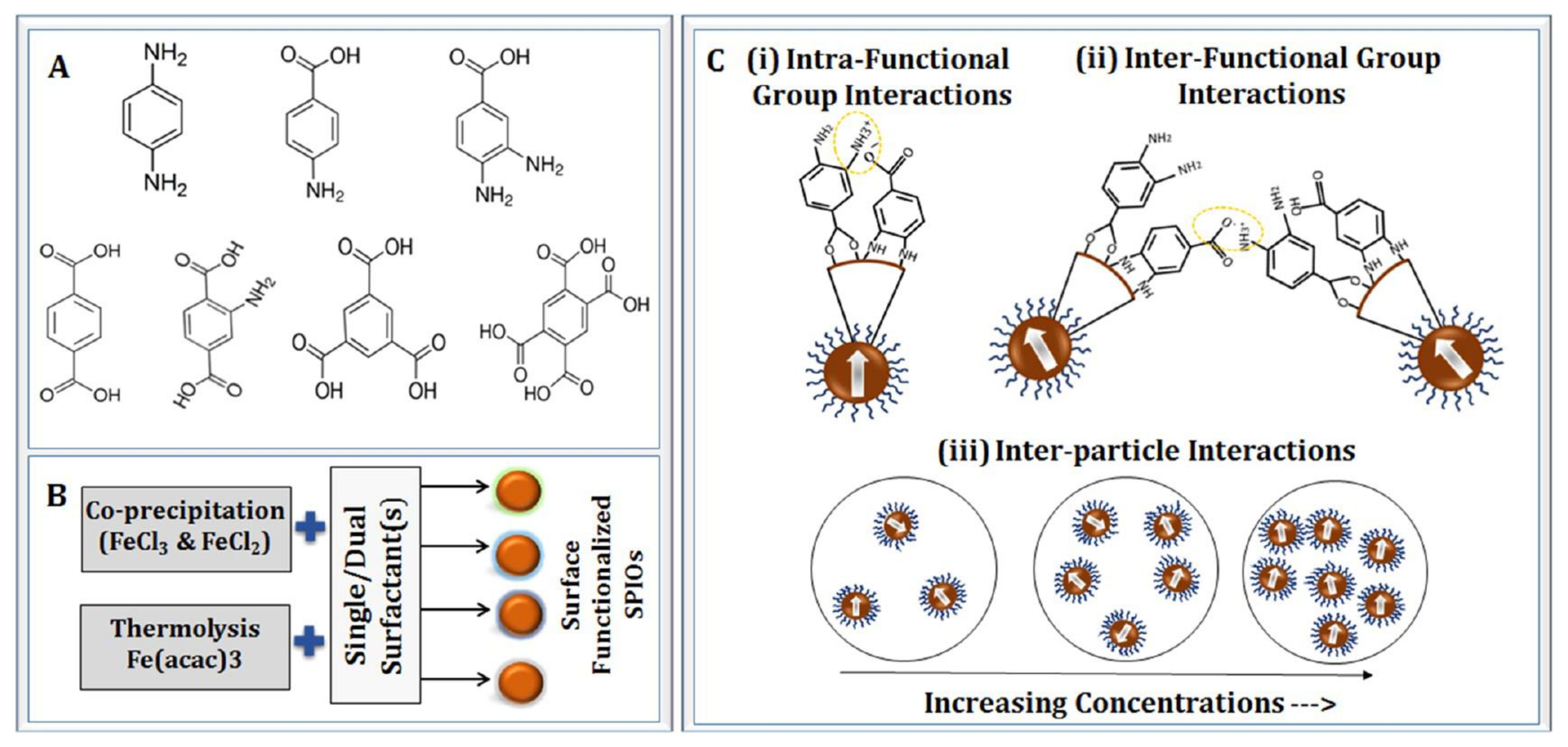
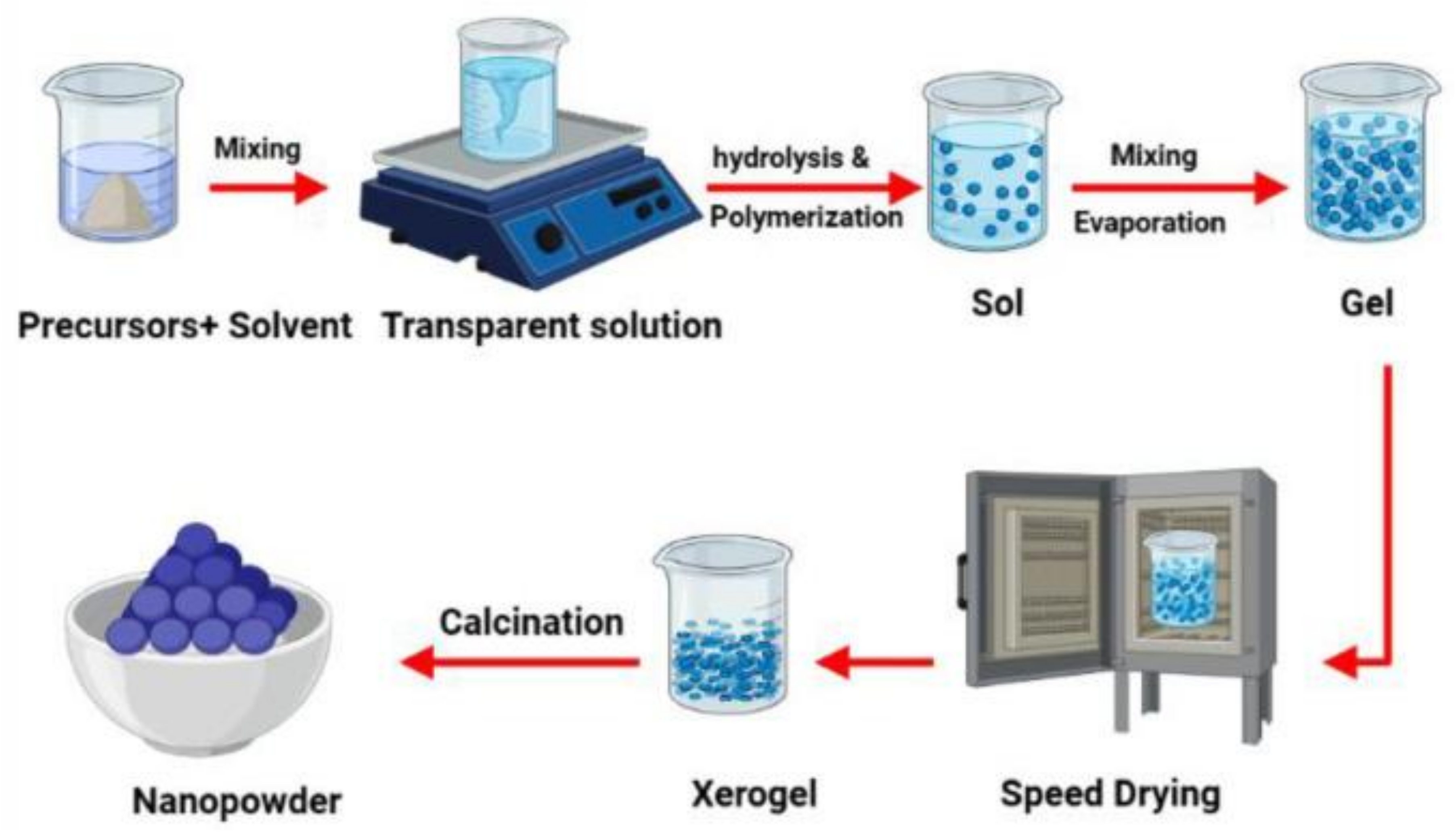
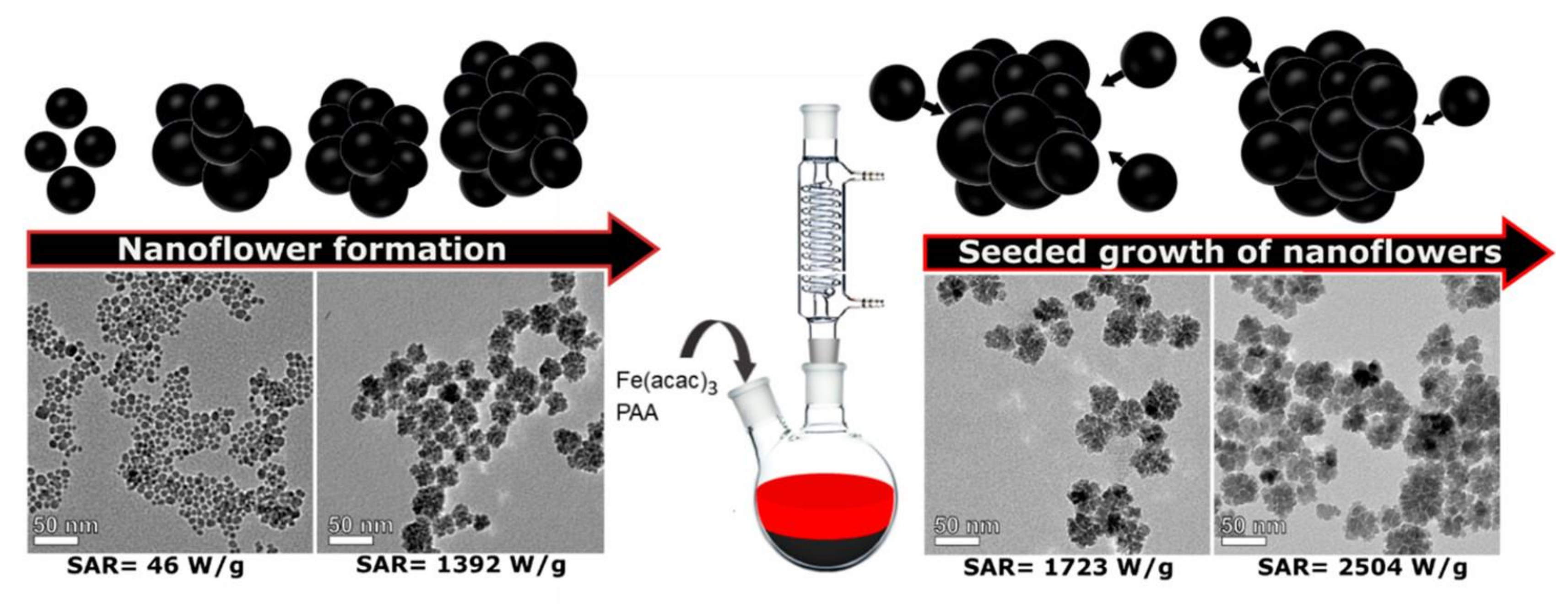

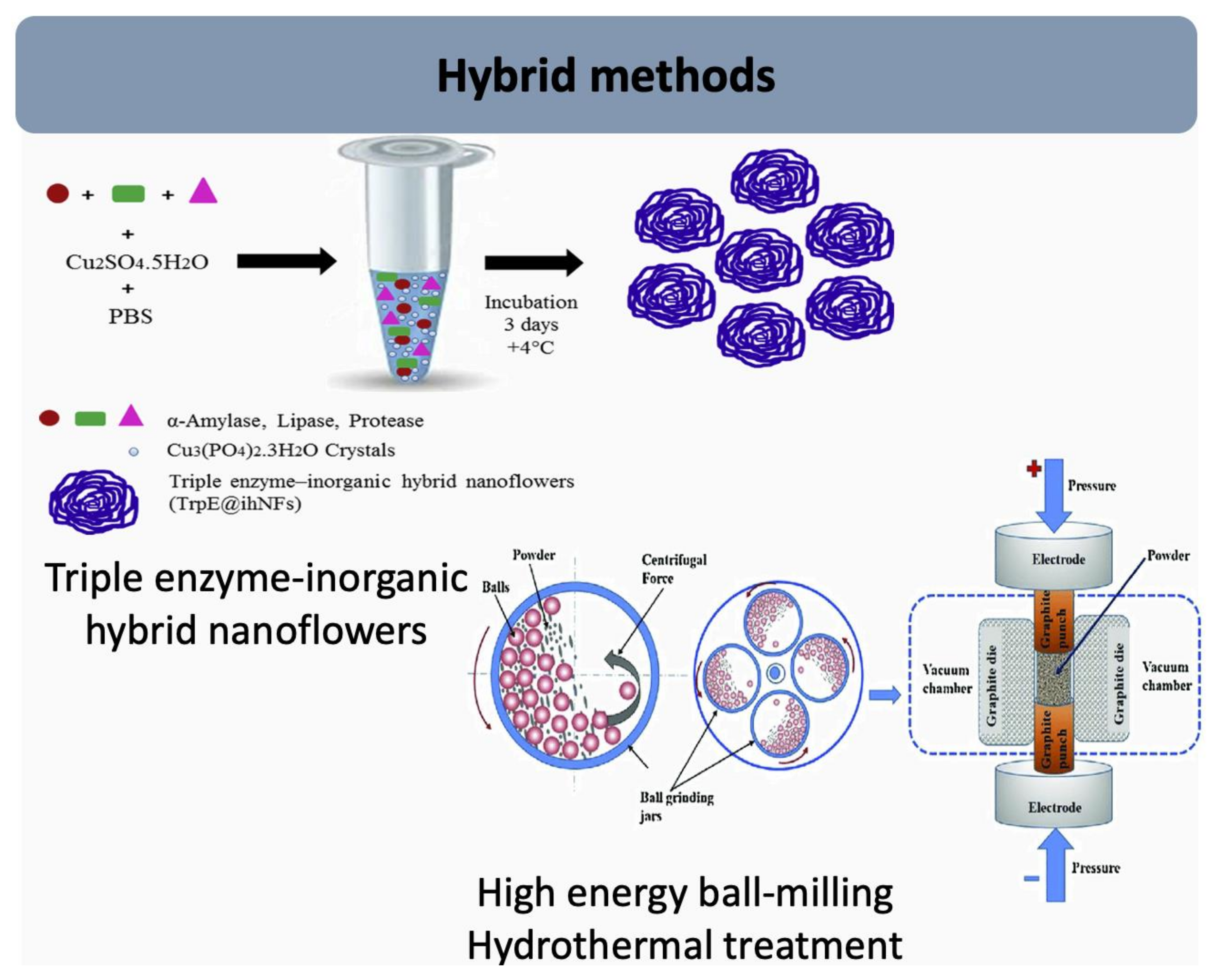
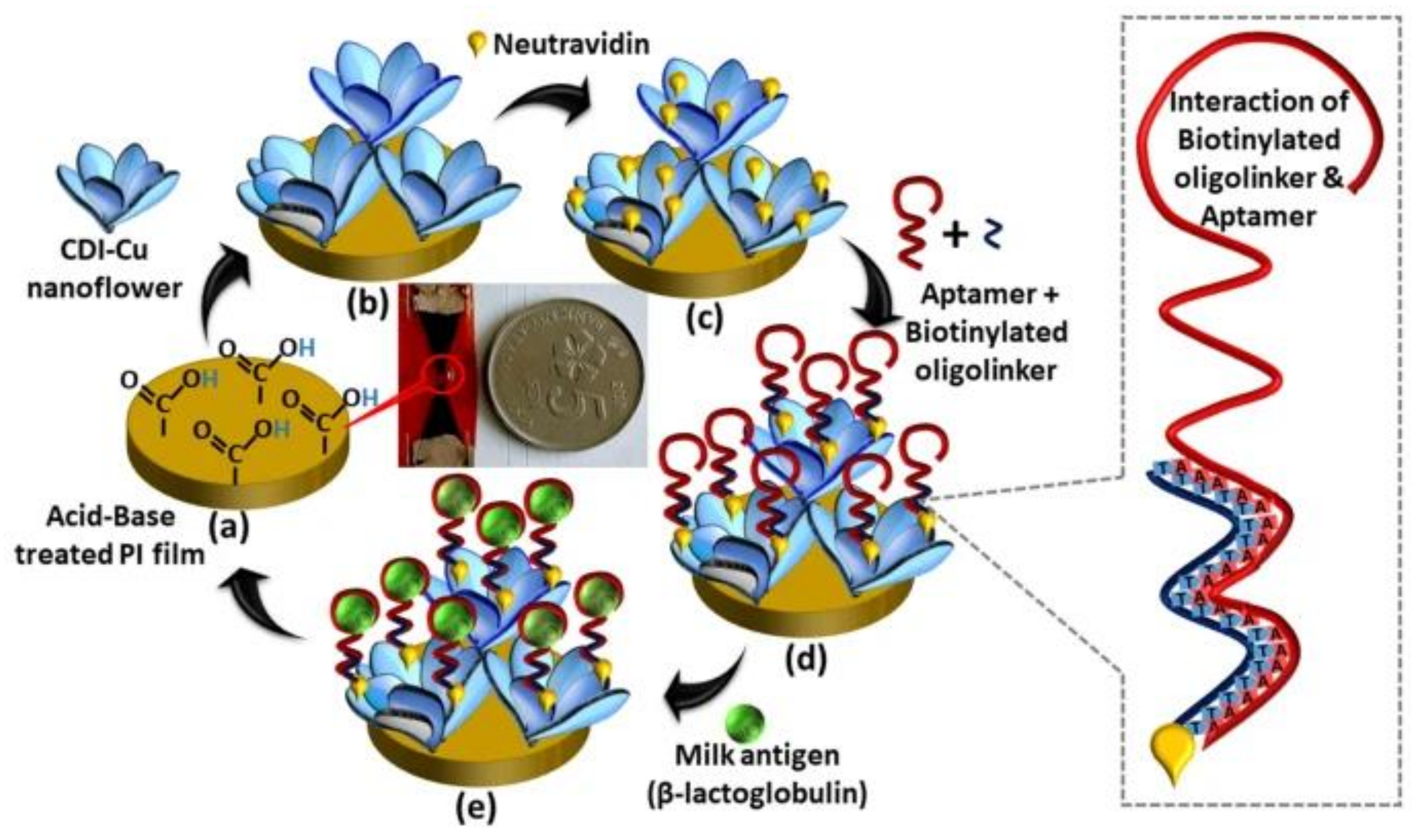
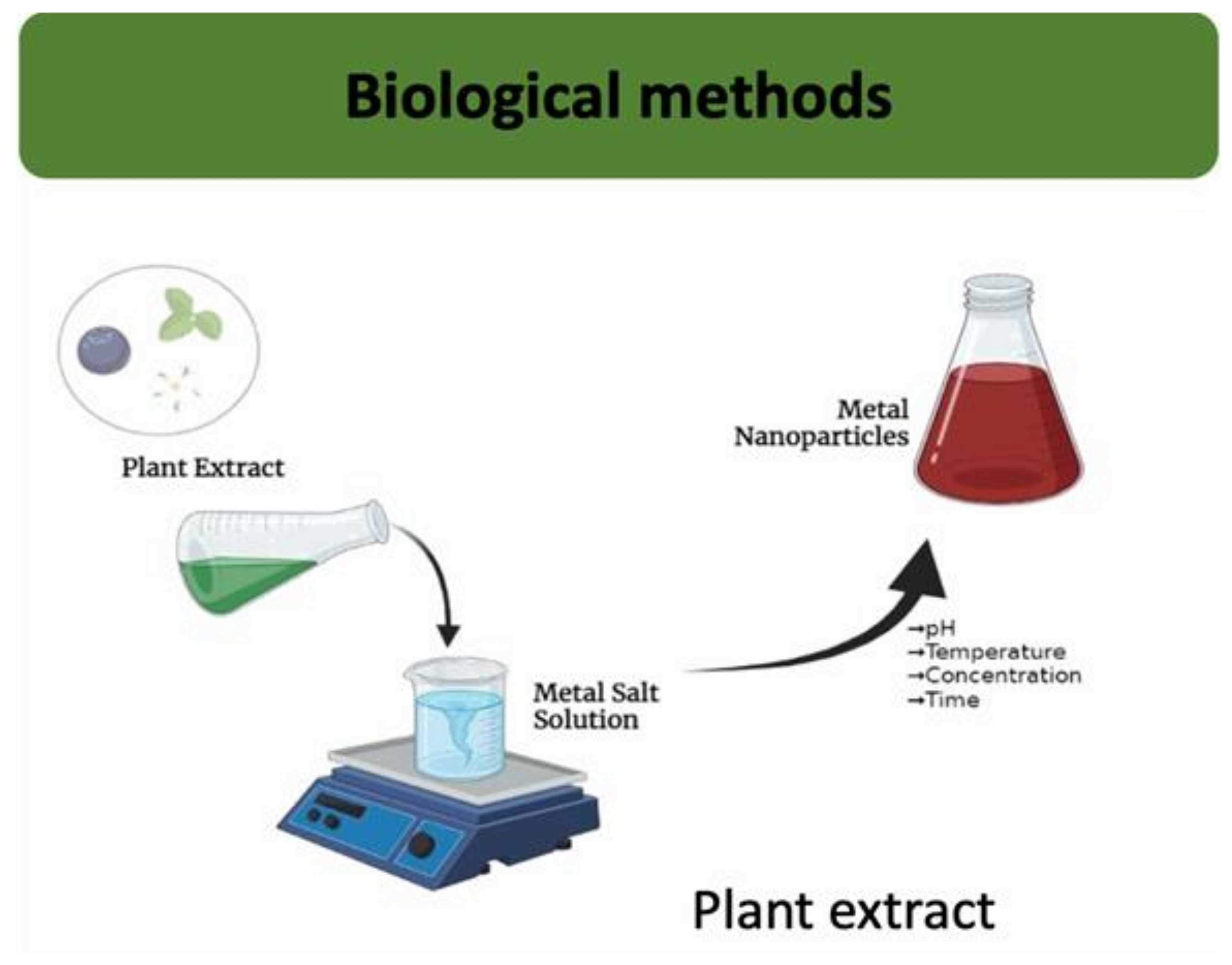
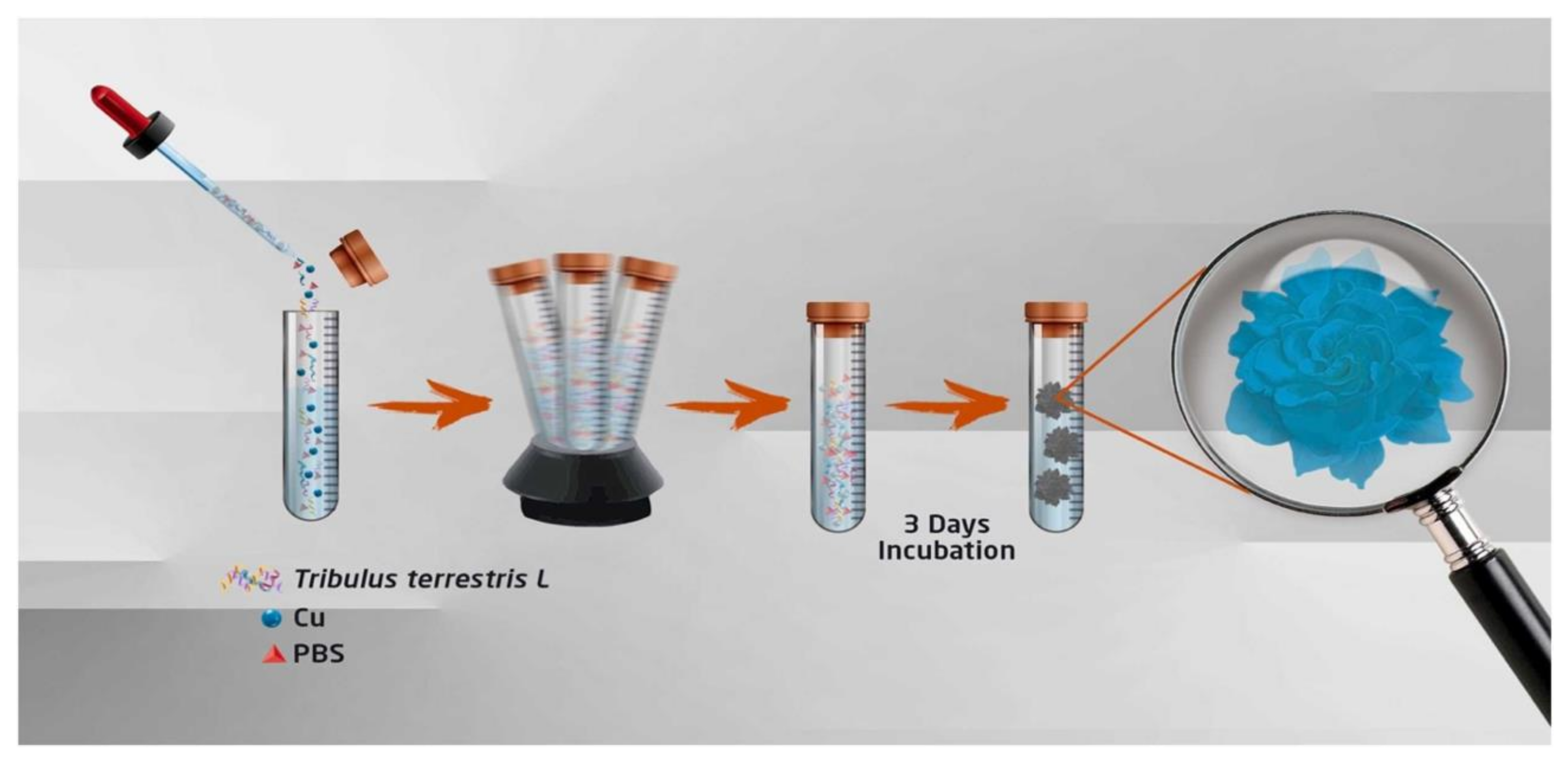

| Synthesis Method | Advantages | Drawbacks | Economic Considerations |
|---|---|---|---|
| Co-precipitation | The particles generated are relatively less toxic and simpler to produce [42]. | Reactants need to have similar precipitation rates [34]. | Low cost of chemicals [43]. |
| The synthesis occurs at a lower temperature compared to other conventional methods [42]. | There are possible impurities in the product [34]. | ||
| This is a fast method [44]. | It requires waste management in non-aqueous solutions [34]. | ||
| It has the ease of industrial scaling up [44]. | It produces a low yield [44]. | ||
| Sol–gel | It has high purity [45]. | It cannot be applied on a large scale [46]. | Low energy consumption due to mild temperature usage [47]. |
| It has a uniform size distribution [48]. | This is a time-consuming process, includes several steps [49]. | ||
| Hydrothermal | This is a non-toxic solvent, green method [50]. | We cannot observe the crystals through the process [34]. | High cost of autoclave [34]. |
| It enables the precise control of size and morphology [51]. | |||
| One-pot biomineralization | Immediate biomimetic mineralization simultaneously combines MNP preparation with surface functionalization [52]. | The produced material frequently exhibits low performance in technical applications, primarily due to relying on pre-existing natural pathways that have evolved over time [53]. | Less expensive [52]. |
| This approach offers an eco-friendly and safe method for synthesizing multifunctional biomaterials, inspiring future researchers in the development of smart materials [52]. | |||
| Additionally, the one-pot technique operates under gentler reaction conditions, is time-efficient, and aligns with the principles of sustainable development [52]. | |||
| Sonochemical | This approach is an environmentally friendly option, and it operates fast without the need for high-temperature conditions [33]. | Predicting the overall reaction mechanism is challenging as it depends on factors such as the type of reactor, the applied irradiation power and duration, and, most critically, the substrates and solvents used. Each material prepared using ultrasound requires the specific optimization of its synthesis conditions [54]. | A cost-efficient approach [55]. |
| Polyol | A high boiling point ensures the formation of well-crystallized materials [56]. Additionally, the reducing medium safeguards the freshly prepared metal particles from oxidation. Its ability to coordinate both metal precursors and particle surfaces enables precise control over the resulting structures and morphologies [57]. These features make it widely used in industrial applications [42]. | It lacks the drawback of a low boiling point, which often necessitates the use of an autoclave [57]. | Regarded as green and cost-efficient solvent [42]. |
| Exhibits solubility for compounds similar to water, enabling the use of simple, inexpensive metal salts as starting materials [58]. | |||
| Assisted by microwaves | It is considered a quick, simple, green approach [59]. | It has pressure sensitivity and penetration depth [60]. | Cost efficiency [59]. |
| There are challenges with scaling up [61]. | |||
| Not all solvents are appropriate [61]. |
| Parameter | Effect on Morphology | Reference |
|---|---|---|
| pH | Depending on pH conditions during synthesis, fully grown, semi-developed and non-developed NFs and HNFs can be obtained | [103,104] |
| Temperature | The temperature window range favoring HNF formation depends on material composition and synthesis process | [104] |
| Incubation time | NF and HNF growth lasts for about 72 h until they “blossom” | [104,105] |
| Immobilization of multiple enzymes | enhancing their biodistribution by increasing the NP’s water solubility | [83] |
| Type of Nanoflower | Synthesis Method | Diameter (nm) | Magnetic Properties | Application | Reference |
|---|---|---|---|---|---|
| Fe0.6Mn0.4O | One-pot high-temperature thermal decomposition | 102.7 ± 11 | ferromagnetic | Theranostic agent for MRI and MHT | [110] |
| Fe3O4@PEG | Solvothermal | 70–250 | superparamagnetic | MRI contrast agent, photothermal agent | [111] |
| γFe2O3@Au | Co-precipitation | 179 | superparamagnetic | PA and MRI agent, photothermal agent | [112] |
| γFe2O3 | Modified polyol | 15.1 ± 2.8 35 ± 3.8 | superparamagnetic | Cellular imaging MHT agent | [83] |
| Fe3O4@PS-b-PAA | Polyol | 49 | n.a. | MRI contrast agent, imaging tracer in MPI, photothermal agent | [113] |
| Fe2O3@Au | Polyol | 25–30 | n.a. | Photothermal agent | [114] |
| γFe2O3@CuS | Polyol | 120.4 ± 7.3 | superparamagnetic | Theranostic Agent (PTT, PDT, MHT, MRI) | [115] |
| Nanoflower Type | Synthesis Parameters | Main Findings | Ref. |
|---|---|---|---|
| Fe0.6Mn0.4O | Temperature: 365 °C; Reaction time: 1 h; Precursors: Mn(acac)2 Fe(acac)3 (0.65:1 mol/mol); Reducing agent/solvent: trioctylamine; Surfactants: oleic acid, oleylamine; Washing solvents: hexane, EtOH. | In imaging: Contrast enhancement in MRI, easier tumor identification. In vitro: Hyperthermia at low dosage against MCF-7 cancer cells. In vivo: Complete tumor inhibition without appreciable side effects on the treated mice. | [110] |
| Fe3O4@PEG | Temperature: 200 °C; Reaction time: 16 h; Precursor: FeCl3 6H2O; Reducing agent: NaAc 3H2O; Stabilizer: PEG; Solvent: ethylene glycol; Washing solvents: EtOH, DI H2O. | In imaging: Magnetic properties for MRI monitoring of the therapeutic process. As a PTT agent: Under 808 nm laser, Fe3O4 NFs are more efficient than the reported Fe3O4 NPs. In vitro and in vivo results show that they are comparable to black TiO2@PEG NPs. | [111] |
| γFe2O3@Au | Temperature: 100 °C; Reaction time: 13 h; Precursors: FeCl3 6H2O, FeCl2 4H2O (2.6:1 w/w); Precipitating agent: NaOH soln (1.5 M); Oxidizing agent: HNO3; Solvents: HCl soln (0.4 M); Washing solvent: DI H2O. | In imaging: Ultrasensitivity to SERS, anatomical localization using PA imaging, spatial resolution from MRI for tumor localization and boundary identification. As a PTT agent: Efficient ablation of tumor under the NIR irradiation without regrowth. | [112] |
| γFe2O3 | Temperature: 210 °C; Reaction time: 7.5 h; Precursors: FeCl3 6H2O, FeCl2 4H2O, (2:1 mol/mol); Reducing agents/surfactants/solvents: N-methyldiethanolamine, diethylene glycol; Reduction assistant agent: NaOH; Oxidizing agent: Fe(NO3)3 9H2O; Washing solvents: EtOH, ethyl acetate, HNO3 soln (10%), diethyl ether. | In imaging: Could be used in cellular imaging. As a MHT agent: Both NFs’ sizes showed a concentration-dependent magnetothermal response. In vitro: There was no hemolysis or notable changes in the morphology of RBCs. All formulations tested in LLC and CULA lung cancer cell lines exhibited minimal effects without magnetic hyperthermia (MHT). However, following exposure to an alternating magnetic field (AMF), cell viability significantly decreased. | [83] |
| Fe3O4@PS-b-PAA | Temperature: 220 °C; Reaction atmosphere: N2; Reaction time: 1.5 h; Precursor: FeCl3 6H2O, FeCl2 4H2O, (2:1 mol/mol); Reducing agents/surfactants/solvents: N-methyldiethanolamine, diethylene glycol; Reduction assistant agent: NaOH; Solvents: Type 1 H2O, THF; Solubility enhancing agents: citric acid, oleic acid; Stabilizer: PS-b-PAA; Washing solvents: HNO3 soln (10%), EtOH, acetone, methanol, ethyl ether. | In imaging: Great potential for both Fe3O4 NFs and Fe3O4@PS-b-PAA NFs as contrast agents for MRI, with the second one performing exceptionally well as an imaging tracer in MPI. As a PTT agent: Light-to-heat conversion was not affected by the polymer surrounding the NFs. In vivo: Fe3O4@PS-b-PAA are biocompatible with the tested glioblastoma cell line. | [113] |
| Fe3O4@Au | Temperature: 220 °C; Reaction time: 5.5 h; Precursors: FeCl3 6H2O, FeCl2 4H2O, (4:1 mol/mol); Reducing agents/surfactants/solvents: N-methyldiethanolamine, diethylene glycol; Reduction assistant agent: NaOH; Oxidizing agent: Fe(NO3)3 9H2O; Solvent: Type 1 H2O; Washing solvents: EtOH, ethyl acetate, HNO3 soln (10%), acetone, diethyl ether. | As a PTT agent: NPs’ accumulation in CAFs, resulting in a cumulative effect of PTT treatment. The efficiency of Au-Fe3O4 NFs varies based on the injected dose, the irradiation time and the number of laser expositions. Cancer-associated fibroblasts targeted PTT modulates the physical properties of the solid tumors, followed by tumor regression. | [114] |
| γFe2O3@CuS | Temperature: 220 °C; Reaction time: 3.5 h; PrecursorsFeCl3 6H2O, FeCl2 4H2O, (2:1 mol/mol); Reducing agents/surfactants/solvents: N-methyldiethanolamine, diethylene glycol; Reduction assistant agent: NaOH; Washing solvents: EtOH, ethyl acetate, HNO3 soln (10%), acetone, diethyl ether. | Achievement of a reduced NP-administered dose, reduced laser power exposure and the possibility of serial heating cycles and therapy monitoring by photoacoustic (PA) and magnetic resonance imaging (MRI). Achievement of integration of the dual heating capability (MHT + PTT) with the PDT. | [115] |
| Type of Nanoflower | Synthesis Method | Size (nm) | Application | Reference |
|---|---|---|---|---|
| CuS–MnS2 | Hydrothermal | 400 | Contrast agent (MRI), photothermal (PTT) and photodynamic (PDT) agent against ovarian cancer | [117] |
| NGO–FA–CuS | Hydrothermal | 40 | Theranostic agent | [118] |
| Cu-EGCG-ICG-DOX | Self-assembly | 217 ± 18.1 | PTT and chemotherapy agent | [119] |
| Cu7.2S4/5MoS2 | Solvothermal | 200 | Theranostic agent (PTT, PDT, CT) | [120] |
| Hollow CuS | Laser-assisted ablation/ion-exchange | 30–120 | Theranostic agent (MRI, PTT, DOX-mediated chemotherapy) | |
| Cu3SnS4 | Hydrothermal | n.a. | Photoelectrochemical (PEC) detection of human cytochrome c | [121] |
| CaMoO4/MoS2/CuS | Hydrothermal | ~1000 | Enzyme-like action for cancer cell detection and ROS-mediated treatment | [23] |
| Gallic acid–Cu(II) | Self-assembly | 9200 | Anticancer activity against breast and lung cancer cell lines | [122] |
| Nanoflower Type | Reaction Parameters | Main Findings | Ref. |
|---|---|---|---|
| CuS–MnS2 | Temperature: 100 °C Reaction time: 4 h Precursors: Thioacetamide, CuCl2.2H2O, MnCl2 4H2O, (15:5:1 mol/mol/mol); Surfactant: sodium dodecylbenzensulphonate; Solvent: H2O; Washing solvents: EtOH, H2O. | Potential use as theranostic agents for MRI and PDT/PTT for cancer. Necroptosis might be their main anticancer mechanism of action. | |
| NGO–FA–CuS | Temperature: 150 °C Reaction time: 6 h Precursors: Cu(NO3)2; Reducing agent: thioglycolic acid; Solvent: Type 1 H2O; Washing solvents: EtOH, DI H2O; Other materials: Folic acid-conjugated nanographene oxide. | Multifunctional photothermal agent that causes nuclear targeting, accumulation and necrosis of cancer cells by hypothermia. | [118] |
| Cu-EGCG-ICG-DOX | Temperature: room temperature; Reaction time: 4.5 h; Precursor: CuCl2; Solvent: triethanolamine. Drugs: (−)-epigallocatechin-3-gallate, indocyanine green, doxorubicin hydrochloride. | Long-term drug retention in tumor above 8 d. Upon NIR laser irradiation, high NIR-II fluorescence signals could image guide local PTT-chemotherapy of tumors and suppress tumor growth until 14 d. | [119] |
| Cu7.2S4/5MoS2 | Temperature: 200 °C; Reaction time: 24 h; Precursors: (NH4)2MoO4, Cu(CO2CH3)2, thioacetamide, (0.58:1.2:2.3 mol/mol/mol); Solvents: Type 1 H2O, PEG-400; Washing solvents: EtOH, Type 1 H2O. | Both in vivo and in vitro: Synergetic therapeutic effect between PTT, CDT, PDT in vivo: photoacoustic signal amplitudes and computed tomographic contrast enhancement. | [120] |
| hollow CuS | Temperature: 60 °C; Reaction time: 2 h; Precursor: Cu(NO3)2 3H2O; Solvent: Type 1 H2O; Washing solvents: Type 1 H2O; Other materials: ZnO nanoparticles. | Effective theranostic agent for MRI-guided synergetic thermochemotherapy. Exhibits (a) 1.6 times larger longitudinal mass relaxation rate than that of the T1 MRI contrast agent Magnevist and (b) photothermal conversion efficiency of 30%. | [123] |
| Cu3SnS4 | Temperature: 200 °C; Reaction time: 3 h; Precursors SnCl4 5H2O, CuCl2, thioacetamide (13.3:4.4); Stabilizer: EDTA; Reducing agent: NaOH; Solvent: DI H2O; Washing solvents: DI H2O, anhydrous EtOH; | PEC immunosensor detects human serum Cyt c at concentrations of 1 fM-1000 nM (limit of detection: 0.35 fM). | [121] |
| CaMoO4/MoS2/CuS | Temperature: 180 °C; Reaction time: 6 h; Precursor: CaCl2, Na2MoO4 2H2O, thiourea, Cu(NO3)2 2H2O (6:2.5:13:3); Stabilizer: PVP; Reducing agent: citric acid; Solvent: dH2O; Washing solvents: absolute EtOH, dH2O. | Provides MDA-MB-231 cell detection at concentrations of 50–5.5 × 104 cells/mL (limit of detection: 10 cells/mL). By generating reactive oxygen species, cancer cells were treated. | [23] |
| Gallic acid–Cu(II) | Temperature: room temperature; Reaction time: 72 h; Precursor: CuSO4 5H2O, gallic acid; Solvent: UP H2O, PBS. | Cytotoxic effects against MCF7 and A549 cancer cell lines, showing apoptotic cell death percentages of 67% and 65%, respectively. | [122] |
Disclaimer/Publisher’s Note: The statements, opinions and data contained in all publications are solely those of the individual author(s) and contributor(s) and not of MDPI and/or the editor(s). MDPI and/or the editor(s) disclaim responsibility for any injury to people or property resulting from any ideas, methods, instructions or products referred to in the content. |
© 2024 by the authors. Licensee MDPI, Basel, Switzerland. This article is an open access article distributed under the terms and conditions of the Creative Commons Attribution (CC BY) license (https://creativecommons.org/licenses/by/4.0/).
Share and Cite
Vlachou, A.; Gkika, D.A.; Efthymiopoulos, P.; Kyzas, G.Z.; Tsoupras, A. Copper- and Iron-Based Nanoflowers in Cancer Theranostics. Appl. Sci. 2024, 14, 11294. https://doi.org/10.3390/app142311294
Vlachou A, Gkika DA, Efthymiopoulos P, Kyzas GZ, Tsoupras A. Copper- and Iron-Based Nanoflowers in Cancer Theranostics. Applied Sciences. 2024; 14(23):11294. https://doi.org/10.3390/app142311294
Chicago/Turabian StyleVlachou, Agathi, Despina A. Gkika, Pavlos Efthymiopoulos, George Z. Kyzas, and Alexandros Tsoupras. 2024. "Copper- and Iron-Based Nanoflowers in Cancer Theranostics" Applied Sciences 14, no. 23: 11294. https://doi.org/10.3390/app142311294
APA StyleVlachou, A., Gkika, D. A., Efthymiopoulos, P., Kyzas, G. Z., & Tsoupras, A. (2024). Copper- and Iron-Based Nanoflowers in Cancer Theranostics. Applied Sciences, 14(23), 11294. https://doi.org/10.3390/app142311294










